Brewing with Wormwood
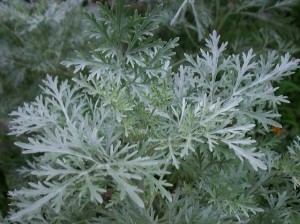 Tonight I brew my first beer of 2014, and like every beer I brewed last year, its a beer that “I’ve been meaning to try for a long time”. I am generally long on ideas and short on time (what with all those pesky brewery tours), so it’s nice when I get to knock a really oddball style off my list. Tonight’s style is Purl.
Tonight I brew my first beer of 2014, and like every beer I brewed last year, its a beer that “I’ve been meaning to try for a long time”. I am generally long on ideas and short on time (what with all those pesky brewery tours), so it’s nice when I get to knock a really oddball style off my list. Tonight’s style is Purl.
Purl is a Wormwood Ale that was popular in Shakespeare’s time, and even mentioned a couple times by The Bard of Avon himself. To be fair, I didn’t pick Purl because of its obscurity, it’s historical significance, or even because I necessarily wanted to taste one. No, my motivation was much more mundane. I just got a couple pounds of fresh raw wormwood delivered to my home-brew shop, True North Brew Supply, and I wanted to be the first to try some. Having said that, I love trying to recreate historical beers, I like brewing obscure styles, and I don’t mind the bitter astringency of wormwood, so major motivating factor aside, I was looking forward to this experiment.
Some 15+ years ago, I used to make quite a bit of absinthe for myself and friends (the statute of limitations is up, right?), importing wormwood and other ingredients from Sweden – but it got to the point where more shipments were getting turned back at the border than were making it through, so I gave up trying.
[wormwood contains thujone, a controlled substance due to its hallucinogenic properties]
Besides, when I got my UBrew liquor license 7 years ago, that put a nail in the coffin of my grain alcohol experimentation days. Not worth the risk. Anyway, to my surprise, a few years ago brew shops began stocking wormwood again… something in the law changed, absinthe and other wormwood beverages became popular again, and wormwood was easier to get than ever. I had brought in a pound of it a couple years ago, and it kinda just sat there. Selling by the ounce, it took 20 months to sell that pound. Now that I had reordered, upon opening up that fresh bag of wormwood the vibrant aroma brought back some good memories, and I knew right there that I HAD to put this in a beer. And soon!
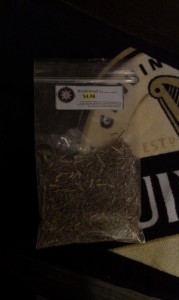 But what style of beer would benefit from a wormwood addition? Wormwood is after all, the 2nd most bitter plant on the planet (after Rue), but being a Hophead, I think I can handle a little bitterness…
But what style of beer would benefit from a wormwood addition? Wormwood is after all, the 2nd most bitter plant on the planet (after Rue), but being a Hophead, I think I can handle a little bitterness…
I was thinking that a Gruit base, or even a simple IPA with wormwood additions for bittering might do the trick, but hey, since Purl was actually an established style that used wormwood, that would be a logical start. One caveat though, I am going to use hops in my beer. (Traditional Purl is unhopped, relying only on the herbs for bitterness).
For completely experimental beers, I generally aim to brew a half batch (about 10 liters). If it’s great, I can always scale up to a larger recipe next time, and if it’s a failure, I won’t be wasting too much beer. Here’s the recipe I settled on:
3.5 lb Marris Otter Malt
1.25 lb Golden Promise Malt
1.0 lb Munich Malt
0.5 lb Carapils
0.5 lb Crystal-15
0.25 lb Belgian Special-B
1 oz Briess Midnight Wheat
1 oz Liberty Hops 60 minute boil
I figured that traditional British base malts was the only way to go, but I’m pretty used to Marris Otter so I decided to throw in a portion of Golden Promise (the Northern UK/Scottish equivalent of Marris Otter) for its sweeter, clean flavour. To darken it up a bit, I was going to use about 4oz of Crystal-120 but opted for Belgian Special-B instead, thinking that it’s slight raisiny quality might offset the wormwood twang nicely. I wanted to shoot for a colour of about 18-19 SRM and BeerSmith said I was still a little light, so I tossed in an oz of Midnight Wheat – one of my great brewing tricks… wheat is huskless, so you do not gain any astringency from its addition, like you would from a typical roasted barley or black patent malt – and, the wheat is a pretty neutral taste, so basically, adding Midnight Wheat is like adding colour, and that’s it.
The Liberty hops have an Alpha Acid rating of 3.8%, so a 1oz addition boiled for 60 minutes in a batch of this size would yield about 23 IBU. The vital stats are as follows:
OG: 1.074 SG
FG: 1.016 SG
ABV: 7.7%
IBU: 23
SRM: 19
Mashing went off without a hitch, I collected 12 liters and hit a pre-boil gravity of 1.068.
Once the wort came to a boil, I added 1/4 oz of wormwood, along with the 1 oz of Liberty Hops.
With 10 minutes left in the boil, I was going to add another 1/4 oz of wormwood along with my Irish Moss, but during the 50 minutes of boil time, I started going through the pantry in my brewery and found some Moroccan bitter orange peel and some Egyptian chamomile, and I though “hey, a little citrus tang from the bitter orange and some sweet pineapple aroma from the chamomile might actually dance around that wormwood astringency nicely” – so, with 10 minutes left in the boil, I dropped in the Irish Moss, 1/4 oz of wormwood, 1/4 oz of bitter orange peel, and 1/8 oz of chamomile.
With the boil complete, and wort cooled to room temperature, I did a quick aeration and dropped in a pack of Danstar Nottingham. I did a lot of thinking about what yeast to use, but after an inner debate about what kind of yeast profile a beer from 1650 might have, I decided that for this test I’d rather not worry about yeast presence, and instead opt for a simple, clean fermenting, neutral yeast. That way, I could appreciate the wormwood, spice and herb additions without any yeast-taste clutter. That’s the theory anyway.
I didn’t quite hit my target gravity. OG ended up being 1.072
BUT, I mashed at 150F, probably lower than a traditional Purl, so I suspect more of those sugars are fermentable and therefore I’ll probably end up with a lower FG ~1.014 … so as far as ABV goes, I suspect I’ll nail 7.7%.
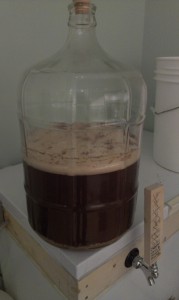 Once fermentation is complete, I’m going to “dry-hop” for a week with another 1/2 oz of wormwood (if you’re counting, that makes an even 1 oz of wormwood in this 3 gallon batch). And I also just decided that I’m going to crack about 10 black peppercorns and drop them in at the same time. I think the spiciness is going to play nicely with the wormwood … at least that’s what my chef-brain is telling me… we’ll see!
Once fermentation is complete, I’m going to “dry-hop” for a week with another 1/2 oz of wormwood (if you’re counting, that makes an even 1 oz of wormwood in this 3 gallon batch). And I also just decided that I’m going to crack about 10 black peppercorns and drop them in at the same time. I think the spiciness is going to play nicely with the wormwood … at least that’s what my chef-brain is telling me… we’ll see!
12 hours after pitching the yeast, activity was evident. 24 hours after, a nice kreusen had formed. At 48 hours, fermentation in full swing. That’s the great thing about Nottingham – I’ll probably be racking out of the primary on day 5, adding my wormwood for a week, and then bottling before day 14.
UPDATE: Jan 20th
I racked into the secondary today, first putting 1/2 oz of wormwood and 10 black peppercorns into the clean carboy before racking the beer over top. Smells pretty damned good!
UPDATE: January 26th
Just bottled it. Holy mother of pearl, it is BITTER! Way too bitter. I bottled it anyway, but I think at serving time I might have to cut it in half with a neutral beer like a regular pale ale. Next time I make this I don’t think I’ll even use half as much wormwood… holy damn…
I’ll update this post again once it’s ready to drink!
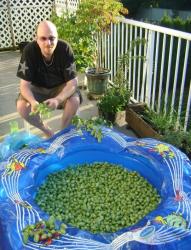

Latest posts by Calvin Quaite (see all)
- Craft Brew, Home Brew, who’s feeding who’s growth? - September 25, 2014
- What is a pint worth? - July 10, 2014
- Kid Friendly Craft Beer Establishments in British Columbia - July 7, 2014
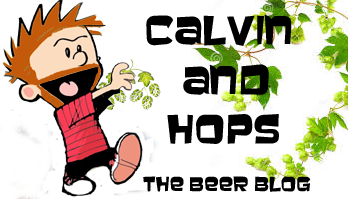
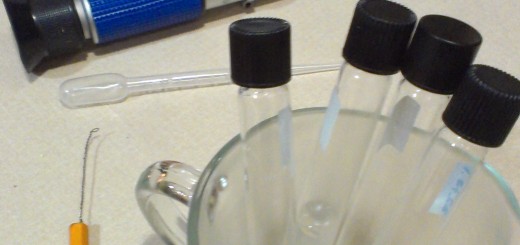
Nice!
oooh i am planning to do this soon, so glad to see results from someone else’s attempt! I’m thinking of bitter orange and clove in mine.
It’s almost been a year now. What’s the verdict? I’m researching my first wormwood addition as I consider a hop-less 2015 (or maybe, a reduced hop 2015).
I used too much wormwood. If I had cut my additions in half, it still would have been just barely palatable. I tried one a month ago, cut 50/50 with a pale ale and was able to finish it, but bitterness was still off the charts. I enjoy the taste of wormwood, and some of my favorite beers are in to 80 to 100 IBU range, but the bitterness is this brew is off the charts. Use moderation when it comes to wormwood! The rest of the beer characteristics came together really well though!
I have been thinking about a wormwood chamomile brown ale for a month now. Yours is the first input I have from another hophead like me. I reasoned that if I like a good IPA, then a whole ounce of wormwood at 60 min should be fine. The gruit folks, I thought, were just not aware of how bitter most home brewers make their beers. On your advice I shall keep mine to 1/2 oz at 60 min and then whirlpool the chamomile from boil to 180f after flame out.
Thanks for a helpful post. I might try to replicate this recipe this weekend, and cut the wormwood in half. Would you recommend any other changes to your recipe?
Also, is that half ounce of wormwood enough to be… active?
Try using 1 gram per liter at only a ten minute steep. That will give you just the right bitterness after a two week condition in the bottle.
He’s right, worm wood should be the last additive, with 10 minutes remaining, try roobious and some ginger to offset the bite
thank you calvin….thank you william…i will just jump like evel knevel and do my 5 regular gallons with half oz….i will post the results….thank you very much.
Just wanted to comment on this. I’ve been playing around with wormwood and other herbal additions and created my own gruit. I found, in a 6-gallon batch, 2 g (TWO GRAMS) of wormwood provided a balanced bitterness hidden behind the herbs (chamomile, sweet gale, yarrow, and juniper berries) and malty post-fermentation sweetness. As Calvin discovered, wormwood is intensely powerful. It’s the second most powerful bittering herb on the plant, next to rue, from what I understand. Calvin used in his 3-gallon batch twenty-eight times the amount I did in my 6 gallon batch. So my recommendation to others who read this is, start very low and taste the cooled wort before the end of your boil. If you need to add more, add more before flameout. Treat it like any other food recipe: taste, taste, taste along the way and slowly add your additions based on this taste. Remember, your wort will be very sweet. You’ll need to use your imagination to remove the sweetness in your mind. When the sweetness ferments out, the dry beer will pull the bitterness forward. My approach was to get the bittering level so I can faintly taste it in the wort. This worked great! After it was fermented out, the amount of bitterness, to my palate, was spot on! Happy Brewing Everyone! 🙂
I see we have a lot of Wormwood Nubies. You can get away with a pinch of Wormwood.